
When planning our round-the-world trip, there were a few places we knew we wouldn’t get a chance to visit. China and India, because they were big and daunting enough to become full trips of their own. The Middle East, because of the volatility of the region. And Europe, because we knew we’d never be able to stay within our budget.
We managed to get a taste of Europe though, when we visited Finland. Why, of all the countries we could have chosen, Finland? Two reasons: It’s the closest country to St. Petersburg, our point-of-entry into Russia, and one of Oksana’s college roommates, Kaisa (who came to Alaska as an international exchange student), lived in Helsinki.
Our flight from Bulgaria actually went south first, for a layover in Istanbul, so it was late afternoon by the time we arrived in Finland and we were tired from a long day of travel. When we reached immigration, the officer behind the counter grilled us. How long are you staying? Where are you going next? Where are your tickets out of the country? How much money do you have?
We had answers for everything but the tickets; we told him that our plan was to buy bus or train tickets to Russia within the week. He was skeptical when we told him we only had 43 Euros on us (which was how much we received after exchanging the remainder of our Bulgarian lev at the airport.) He demanded to know how we would get more money within the country, so I started pulling credit and debit cards from my wallet and snapping them onto the counter. He stopped me at four, stamped our passports, and waved us through.
Kasia was waiting for us beyond customs and, after hugs, she whisked us away from the airport and took us directly to her farmhouse in the countryside, 80kms north of Helsinki. We spent most of the next five days on the farm, enjoying the peace and quiet, but we saw a bit of Helsinki, too, as we somehow managed to make the long trip into the city each and every day we were there.
Geography
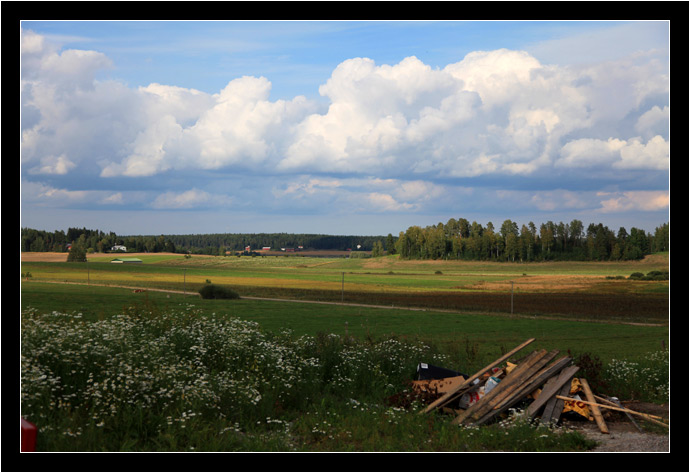
The first thing I thought, as we drove toward the farm, was that Finland is flat! I don’t know why, but I just expected it to be more mountainous. Perhaps it is in the north, I don’t know.
Despite being flat, the area around Helsinki reminded me a lot of Alaska. Thick, tall evergreen trees, long summer sunsets. Makes sense, being at roughly the same latitude as our home in Juneau. The weather was quite a bit better, however, at least in August. Much less rain.
Once we left the freeway, we found ourselves in farm country, and that I never expected. It reminded me of North Carolina, of all places. Small fields boxed in by small forests. Hillier than the terrain near Helsinki, it was spotted with small lakes. Houses were spread out on big plots of land, often with conventional red barns filled with livestock. Quite picturesque.
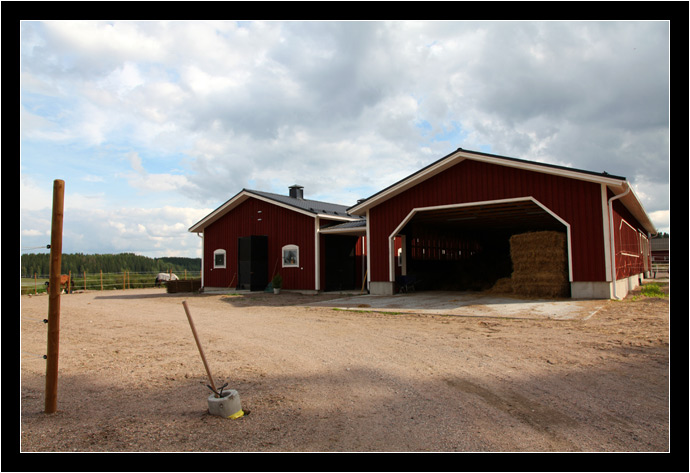
I’m sure Finland does quite a bit of importing and exporting of all sorts of food items, especially since joining the European Union. I have the impression, though, that it is much more self-sufficient than I realized.
Pronunciation
In learning Spanish and listening to other people talk in many different languages, I’ve learned a lot about my own English. For instance, I have the very (American-centric) habit of accenting the second syllable of any word I’m unsure how to pronounce. People who live there, don’t pronounce Helsinki the way we do in the States. It’s not “hel-SINK-ee,” it’s “HEL-sink-ee.” Reminds me of a similar situation we encountered in Tanzania.
Language
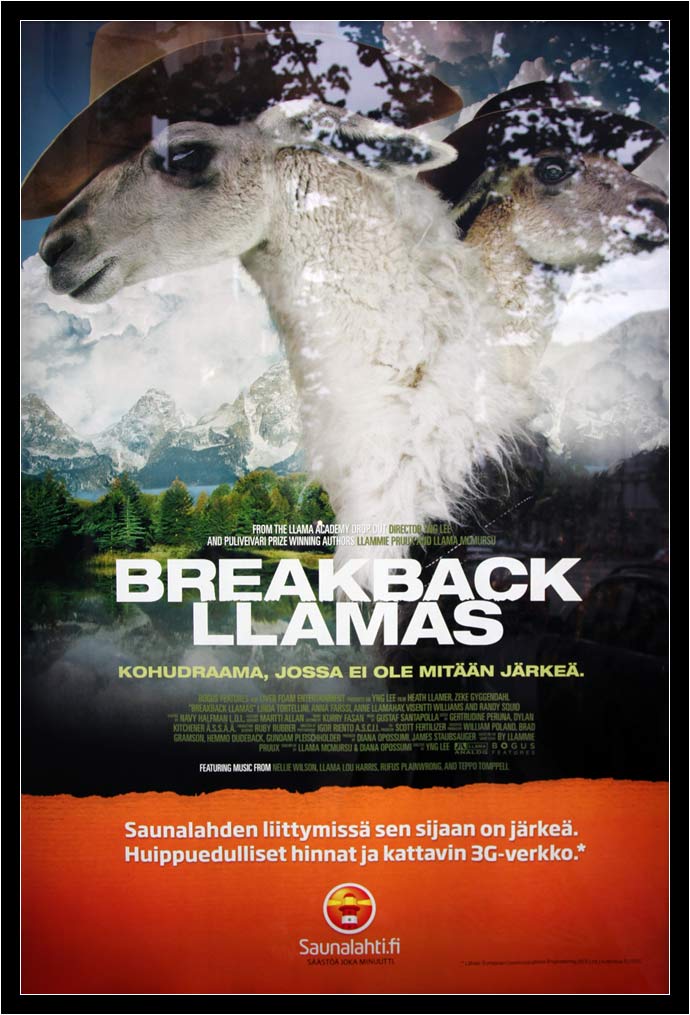
In the short time we were there, the Finnish language was an incomprehensible barrier to us. In speaking situations, it wasn’t a problem at all, of course, because everyone also speaks English. Wandering around the city was another matter entirely.
Most of the maps and all of the streets were labeled in two languages, which would have been quite helpful if Oksana or I spoke Swedish. As it turned out, when we were following directions, we had to double- and triple-check each intersection to puzzle out the long names comprised mostly of consonants.
While Finland makes plenty of allowances for people literate in Swedish, they don’t often do the same for English-speakers. When we tried to buy tickets for our commuter train into the city from an automated kiosk at the station (the only way to purchase them before getting on the train), we realized we had absolutely no clue how to navigate the screens. Running short on time, we flagged down a passing Finn and ask them to translate for us. She was super helpful, running us through the options, right up until it asked us for payment with a “chipped” credit card… which American banks, of course, don’t yet issue. We ended up buying our tickets with cash, on the train.
Stereotypes
The teenagers on the streets of Helsinki looked like they were putting on a revival of 80s fashion. Big hair, eclectic clothes, the whole works. I spotted a fair amount of punk-rock fashion and hairsytles, too.
Toward the end of our stay, I remarked that the younger generation of Finns seemed to be trying to rebel with their fashion. Any way to stand out of a crowd, a rebellion against the status quo made up of clothes and hairspray.
Jason, another American who had been in Finland much longer than we had, had a different opinion. His told us that Finland is the most “American” country in Europe and most of the kids we saw weren’t rebelling at all, but rather doing their best to import what they perceived to be our culture in the States.
I’ll defer to his judgment. He’d spent months there, while we only had a handful of days.
Safety
Oksana and I planned to spend at least one day walking around Helsinki and taking pictures. Before we did, I asked our hosts how safe it was to wander around with an expensive camera (something I’m always concerned about.) Helsinki seemed safe to me, but often there are areas in any big city that you don’t want to wander into.
They just laughed at me. Kaisa’s husband, Aleksis, recalled a time a few years ago when there was a rash of pick-pocketing within the public transportation system, but it became a huge issue – making the news, it was so rare – and quickly faded away. He pondered the question for a bit, then told us he couldn’t remember hearing of a single mugging. Nothing where violence, or even the threat of violence, was used.
Public Transportation
It’s easy enough to get around Helsinki, albeit quite expensive, via public transportation. On our last day, we took a high-speed train in from the countryside and it cost us $9.50 USD each, one-way. Business commuters, at least the ones living that far out from the city center, must spend close to $20 USD per day on transportation.
Once within the city, there’s a network of trolley cars and buses that will take you anywhere you want to go. The routes are usually easy enough to figure out, (see the language section, above), but again, it can be expensive if you have to use them all the time. We paid €5 to get to from the bus station to the port, which was totally within walking distance if we hadn’t had our giant backpacks and if it hadn’t been pouring down rain. Furthermore, while those five Euros entitled us to ride around on any tram line, our tickets were only good for a couple hours from the time they were purchased. When our ferry was cancelled due to weather, we had to buy new tickets back to the terminal!
I didn’t remember to write down how much gas prices were in Finland, but I remember them being quite high. Even so, with public transportation costs so high, it wouldn’t take much to make car-pooling an attractive option.
Perhaps because of the cost of transportation, the city has created an extensive network of bike paths. It seemed like every street we walked had a thin lane devoted to bicycle traffic. Trails through parks were often split down the middle, one side for pedestrians, the other for bicyclists. Oksana and I wandered over the divider many times, not yet used to the concept of such a strong bicycle culture.
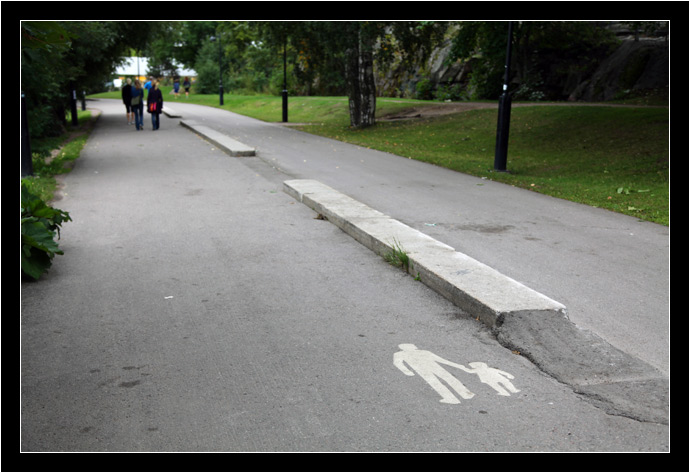
Cost of Living
While we were in Europe, we read about Sweden laying down an ultimatum for the European Union. In an effort to attract foreign markets, the EU has intentionally devalued their Euro, and because of that, Sweden’s kroner has become a very “strong” currency in comparison. So much so, that people in the European Union are avoiding Sweden because the exchange rate doesn’t work out in their favor. Sweden told the world that they were prepared to devalue their own currency, by printing more kroner, to bring things back to a reasonable exchange rate. Of course, we’re doing this with our own dollar right now.
Finland might have to do the same thing.
If anything, Diet Cokes are the “Big Mac Index” for us. We buy at least one can of Coca-Cola Light practically every day while we travel, so we have a pretty good idea of how much it costs from country to country. Finland’s Diet Coke was, hands down, the most expensive we’ve ever seen. Call it $2.50 to $3 USD per 500ml (20oz) bottle. We drank a lot of off-brand diet soda while we were there.
When we crossed the border into Estonia, for comparison, the price dropped all the way down to slightly under $1 USD for the same amount.
Finland is spendy.
Parking
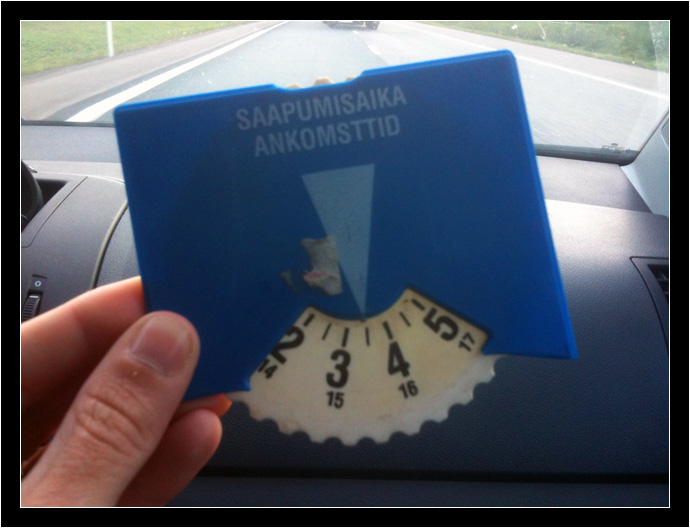
I haven’t come across a system like this before, so I don’t know exactly how it works, but paying for parking in Helsinki is a bit weird. As a driver, you get a little code wheel thingie that you put on your dashboard. I guess you just turn the wheel to indicate what time you parked and leave it in plain sight for the meter maid. If you exceed your allotted time, I suppose they write you a ticket.
Sort of feels like an honor system approach, but I guess you can’t game the system without some effort. Best you could do is run down to your car on a coffee break and turn the wheel a bit. You wouldn’t have to drive to a new spot, but you’d still have to leave work (or whatever.)
Saunas
Much like Russia, Finland has both a sauna and summer house culture. What this means is that families often have cottages, sort of like we have cabins in Alaska, where people can congregate on weekends and holidays.
Imagine a small, rustic house on the shore of a shallow lake. Inside is a sauna with a wood stove that heats a small room to an almost unbearable temperature. You strip down, sit inside with friends for a few minutes, then step outside in the brisk night air just before you overheat. Have a drink, cool down, and repeat as often as desired.
Oksana and I got the impression that Finns are more sexually liberated and less body-image conscious that Americans. I wonder how much of that comes from their sauna culture, where it’s socially acceptable to sit around in a group while both naked (or at least scantily-clad) and sweating.
I also wonder if Finland subscribes to the whole “whipping you half to death with birch branches” in a sauna like they do in Russia. I don’t know; no one offered me a beating.
Alcohol
From reading up a little online, it sounds like Finland, collectively, has a drinking problem. That meshes with what we saw and heard during our time in Helsinki.
First, there’s the confusing manner in which alcohol is sold. If you want a beer, cider, or long drink, you can pick them up pretty much anywhere. In fact, anything with less than 5% alcohol is readily available. Anything stronger, you can only buy from a government-run liquor store. On top of that, there are all sorts of restrictions – no sales after 9pm, multiple drinking ages, high state taxes – that don’t seem to be doing much good. Statistically speaking, alcohol has been the top killer in Finland over the last few years.
Personally, I loved the fact that you could pick up “tallboy” cans of ciders and other “cheerleader beers” at the supermarket. I’m not a big drinker, but I do have a weakness for a crisp hard cider! I didn’t get a chance to try any of those gin-based “long drinks,” but I could tell just by the variety on display that they were filling some pretty big niches.
I was surprised to hear our friends – who are only in their early 30s – complain about how bad the “kids” can get on the weekends. We were there during of once-a-month, city-wide, gallery walk sort of occasion, but our friends wanted nothing to do with it. Seemed to us like a great touristy thing to do, but they quickly talked us out of it. Roving bands of obnoxious, binge-drinking high school and college kids throughout the city? No thanks.
Of course, the government recognizes the alcohol problem and has tried to tackle it. In the past, they heavily taxed all alcoholic products, but that backfired when Estonia joined the European Union. Instead of purchasing domestic drinks, which at least had the benefit of helping the local economy, people just made liquor runs on the Tallinn fast ferry. The government was forced to lower their taxes so that Finland’s companies could stay competitive, but as you can imagine, that didn’t do anything to lessen the country’s alcohol consumption.
Tough problem to solve. We Americans know, from our own history of prohibition, that banning alcohol isn’t the answer. (And from further reading, I just discovered the Finland had its own period of prohibition, too!) If we want to end binge drinking, I guess we’ll just have to dump a ton of money into counter-marketing, over the span of decades, like we did with tobacco. Education through advertising.
Licorice
The world can be divided into two types of people: Those who like black licorice and those who don’t. I always thought I was one of the former.
I love black licorice! (Which is, sadly, unfortunate for my wife…) The best I’ve ever had, we found in the duty free section of Sydney’s International airport – whatever brand we picked up there was both flavorful and oh-so-soft. I never expected to find anything better, but I have long heard tales about the “salty” licorice of Finland. I asked Kaisa for a primer during our first grocery store visit.
Salty licorice is known as “salmiakki” in Finland. It was just about the worst thing I’ve ever put in my mouth, and yet, I so wanted to like it! I couldn’t figure out why it tasted like a used cat litter box to me, but others liked it. Regrettably, I kept tasting different brands and flavors, trying to figure it out.
After reading up on it, I discovered why it tasted more like “burning” to me than “salty.” It’s not sodium chloride they make it with, but rather ammonium chloride. Suddenly, I realized where the cat-pee taste came from and gave up on trying liking it. I still can’t understand how so many Finns can stomach the taste.
Aleksis bought me salmiakki ice cream on two separate occasions. The sweet licorice ice cream inside was heaven; I could eat a couple pints of that in a sitting. The outer shell, however, was salmiakki. The combination of the two forms of licorice resulted in something that was… tolerable… but I wouldn’t have gone out of my way to buy it on my own.
The good news is that Finland has lots of licorice, both salty and sweet. I was able to find a brand, sold in a candy bar form-factor, that I fell in love with. Still not as good as the Aussie stuff, but close.
Good thing we’re ending our journey Down Under. I’m craving licorice again!


You must be logged in to post a comment.